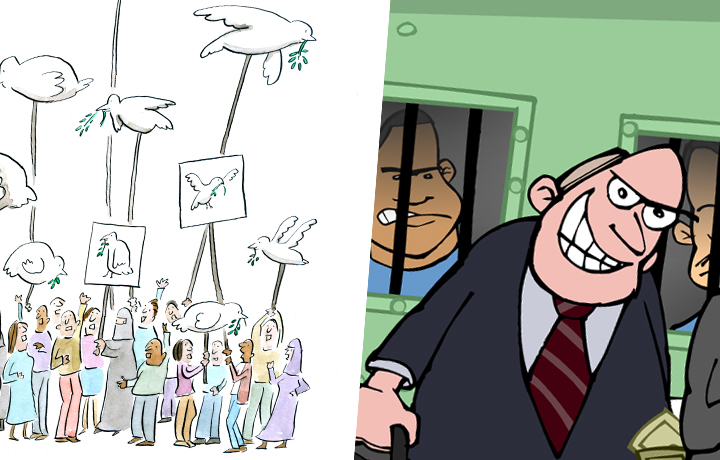
With politics firmly in the headlines both in the UK and USA, Varoom talks to four pioneering US image-makers about how the political cartoon is evolving.
For a generation of people, the caricature on the newspaper Opinion pages was a brisk corrective to what was perceived as the outrages of politicians and governments. But in an age when the printed newspaper is either closing or transitioning to digital, how is the political cartoon evolving? In a frank and provocative series of interviews published in Varoom issue 29, four exceptional US image-makers – Molly Crabapple, Jen Sorensen, Liza Donnelly and Mark Fiore – talked to us about the changing forms and contents of the political cartoon in the 21st Century,
Liza Donnelly and Mark Fiore are below. Read about Molly Crabapple and Jen Sorensen in part one.
Liza Donnelly
Writer and cartoonist with The New Yorker Magazine, Liza Donnelly has been drawing cartoons about culture and politics for over thirty years. Donnelly draws a weekly political cartoon for Medium, and she is a contributor to many other national publications. Donnelly has traveled extensively for her work. She is a Cultural Envoy for the US State Department, traveling around the world speaking about freedom of speech, cartoons and women’s rights. The author/editor of sixteen books, her most recent is Women On Men, published by Narrative magazine.
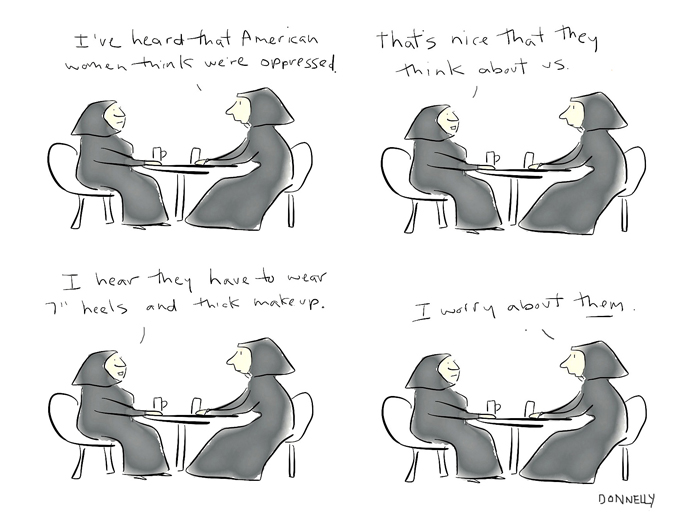
Varoom: How has your image-making as a cartoonist changed over the last 30 years?
Liza Donnelly: There have been many shifts – some of them unconscious, some deliberate – over the course of my career. My early cartoons were often captionless and many of them were sequential. I got the ideas usually through drawing, and less through words. Over the years, I became more comfortable with words and used them more often, relying on captions much more, and almost exclusively. I learned to play with words and make them work with the art. My style stayed fairly consistent until the 1990s when I began drawing more women speaking in my cartoons; it wasn’t conscious, but evolved from encouragement from the editor at the time. Then after 9/11, I made a promise to myself to draw more political cartoons; I had always sold some to The New Yorker. I did more. This choice coincided with the arrival of the Internet and I soon found outlets online for my political cartoons. So now I publish weekly on the Internet, and I find Twitter is a good audience to share my cartoons with. I also use my iPad to quickly draw what I am seeing at events such as news conferences, political debates, awards shows and tweet out impressions. This has become popular and I now am getting paid to attend conferences and events to live tweet-draw things I see.
How have conceptions of ‘the political’ changed?
For me, political means more than just politics and politicians, but also culture. The political is how we interact with one another: racism, sexism, classism, and orientalism. Daily life can be political, particularly for women.
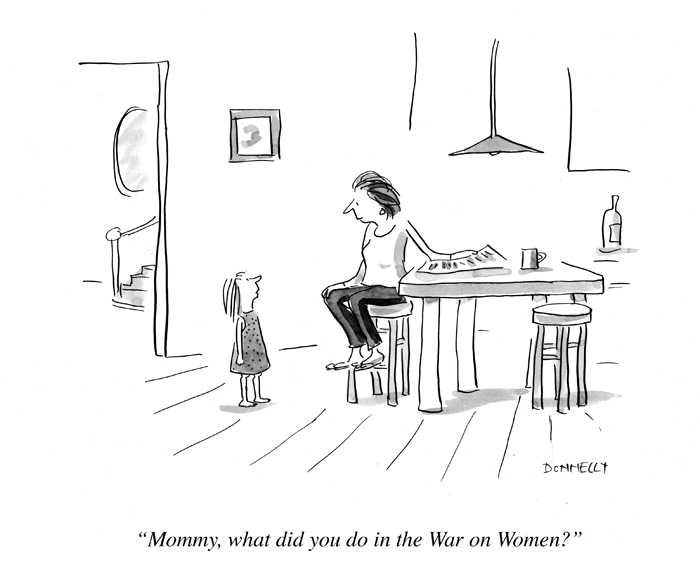
The New Yorker of course is the great bible of cartoons, and when you started in 1982 you were one of only three cartoonists. Were there any ‘political’ themes (in the broad sense) in your book Funny Ladies: The New Yorker’s Greatest Women Cartoonists And Their Cartoons?
Oh, yes. Most of the book consists of profiles of the women who have contributed cartoons from 1925 to the present. But a lot of the book is about their struggles doing so, sexism and other difficulties. But I also provide an overview, because when I looked at the history of the women at the magazine, I saw a trend: there were women drawing cartoons in the 1920s, but then women cartoonists disappeared in the middle of the decade, only to return to its pages in the 1970s. This follows the two waves of feminism, and is demonstrative of how freedom is conducive to creativity.
Men have traditionally dominated the world of the newspaper op-ed cartoon, the satire of a specific kind of power. Why do you think that is, and do you think women cartoonists are getting more opportunities to explore and expand the ‘cartooning of power’?
More and more women are getting into cartooning; a few are doing editorial cartooning. But it is still dominated by men. I think that the existence of the Internet is allowing more women to get their work seen, because there are fewer “gatekeepers.” But there isn’t much money in Internet publications, so it makes it harder to make a living. Historically, women have not been encouraged to share their opinions, so not unlike op-ed pieces; women have not drawn political cartoons. It’s great to see more women entering the field of cartoons, and sharing their views on global issues.
In 2012, as a cultural envoy of the US State department, you went to Israel and Palestine to discuss the political impact of cartoons in the region and international women cartoonists. What were the key insights from your talk?
I am not an expert in any way on Israel and Palestine, so I didn’t speak about the region specifically. I don’t remember the specifics of my talks. I know, however, that I spoke about using cartoons to impact people and further dialogue. Cartoons often engage viewers in ways words cannot, as imagery can be emotional and speak to the heart and not the intellect. This is often where the power of cartoons is most apparent. I often express how cartoons can be used to bridge differences— we all laugh, so why not laugh together? Concerning women, in many cases the problems that they face are daily occurrences; cartoons can visually depict these issues and show what is at the heart of the problems through imagery. My trip to this region was quite powerful, and I enjoyed meeting with cartoonists from both Israel and Palestine, and I learned a great deal about how both sides have pressures and difficulties speaking the truth in their work. It was clear that there were pressures from the publications as well as pressures from the respective communities.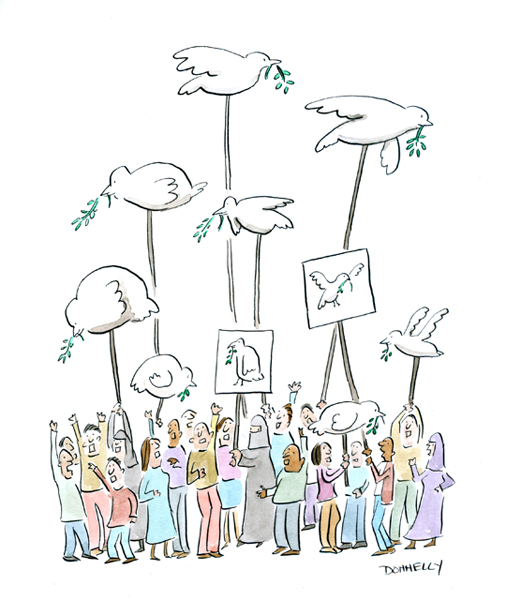
Which particular work of yours has had the most impact?
That’s hard for me to answer. I don’t really know how to measure the degree of impact my work has had. I know the talk I gave for TED in 2010 has had over a million views, and is translated into 38 languages. In that talk, I use cartoons and discuss how powerful humour is personally for me, and as a tool in the world for change. Lately, I have been doing cartoons for Medium.com that are stronger than anything I have ever done. I draw about rape and abuse in the USA and globally. I hope these cartoons are having some impact. One cartoon that had great impact on me was the cartoon I drew after 9/11. I was devastated by the attacks and wondered if I could draw cartoons again. Then I drew this one, and The New Yorker printed it. I felt very happy to be able to contribute, if even in a small way, to what had happened. That’s when I vowed to myself to do more political cartoons moving forward.
The future of ‘political’ imagery?
Respect for cartoons has never been stronger, people understand their power. We understand its limitations, and its ability to cause harm and death. Hopefully we can use the pen and ink to bring people together. I like to say that my pen is not a sword, but an olive branch.
Follow Liza Donnelly: @lizadonnelly and lizadonnelly.com
Mark Fiore
Pulitzer Prize-winner, Mark Fiore, who the Wall Street Journal has called “the undisputed guru of the form,” creates animated political cartoons in San Francisco, where his work has been featured on the San Francisco Chronicle’s web site, SFGate.com, for over ten years. His work has also appeared on Newsweek.com, Slate.com, CBSNews.com, MotherJones.com, NPR’s web site and on cable and broadcast outlets across the globe.
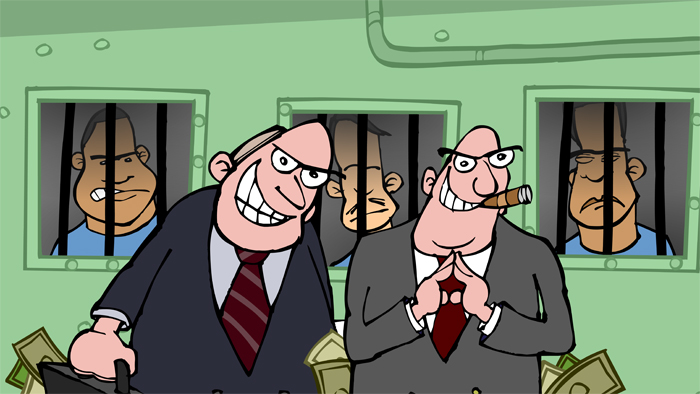
Varoom: You began as a traditional editorial cartoonist. When did you begin experimenting with animation?
Mark Fiore: My first experiments with animation, or animated political cartoons as I called them then, was in the late 1990s. At the time I was doing about eight or nine traditional print political cartoons a week and was supporting my political cartooning habit by taking freelance jobs on the side. One of those side jobs (doing cartoons for an educational website) was where I first experimented with Flash animation. It was probably the second version of Flash and I thought it’d be fun to use that new technology with my traditional political cartoons. After the weekly animation began to sell, I eventually stopped doing the print political cartoons in 2003 or so.
 In making animated political cartoons, how did you discover/create a new process and aesthetic for your work?
In making animated political cartoons, how did you discover/create a new process and aesthetic for your work?
My very early animated cartoons were basically repurposed print cartoons. Some of the earliest ones were multi-panel cartoons that I just broke up into their individual frames, had the text balloons write on and added a few character eye-blinks. Remember, there was no high speed internet to speak of in 1998 or 1999 so these files had to be about 70k or less! And since really nothing else yet moved on the Internet, people were blown away when anything moved. In other words, the bar for online animation was very low when I first began.
Having always loved animation and having been a freelance character designer on some projects, I knew enough about the basics of animation to be able to revel in the ability of doing it myself on a desktop computer. As more was possible online, I was able to do more with my animation. Now everything is everywhere so there really are no technical limitations to what you can create for digital. It really just comes down to time and money on the production and art side, to put it crassly.
Creatively, early on I decided I wanted my work to maintain a hand-drawn look. I had worked so many years to revel in the brush line, I didn’t want to lose that when my work moved to a computer. I still draw with a brush on paper and then scan that in (no Cintiq yet). Even though my work doesn’t come close on the artistic side, in my head I’ve always aimed for a cross between Pat Oliphant and Chuck Jones.
 How do you settle on a subject? What is the relationship with your editor? How long does it take to make?
How do you settle on a subject? What is the relationship with your editor? How long does it take to make?
The best way to settle on a subject, whether for traditional political cartooning or for political animation, is to focus on what pisses you off. If I’m reading/watching/listening the news and something jumps out at me as being hypocritical or ridiculous, that is the topic towards which I’m drawn. My editors have a very hands-off approach. At this point I’m mostly left alone to create the weekly animation (Though I will occasionally do exclusive work, which generally involves more interaction with the client/editor).
Most of my animation is in the two-minutes-or-less range and, if it is the weekly animation that only involves me, will take about three days to crank out. My deadline has been end-of-the-day Wednesday for years, so on Monday I will focus on the journalism side: doing research, digging into the story, writing the script. Tuesday morning is generally storyboarding, or really more thumb-nailing, then drawing and animating while recording audio. Wednesday is more animating, finishing the audio and synching everything together. It’s a pretty brutal schedule for mostly one person. At times I’ve had assistant animators, but don’t right now.
Which particular work of yours has had the most impact?
It depends on who is feeling the impact. Cartoons about gun control send the gun nuts into fits of rage. Gay marriage cartoons, as that issue has changed in the United States, generally receive a very positive and supportive response. Strangely, the cartoon that brought me the most death threats was about the Tea Party.
The future of ‘political’ imagery?
All I know for sure is that political imagery will always be around. I’m less clairvoyant in knowing where that imagery will appear. If the Internet disappears or the asteroid hits, political imagery will surely be scrawled on walls or tablets of wood. As of now, everything seems headed for the phones and various handheld devices, as well as still on desktop and laptop computers. The important thing for someone in this line of work is to be adaptable and not get too frustrated with the various places your work may show up – it can be a good thing! Even when Apple or Google start making the retinal implants or some such, political animation will have a place there, as will static political cartoons.
Follow Mark Fiore: @MarkFiore and markfiore.com